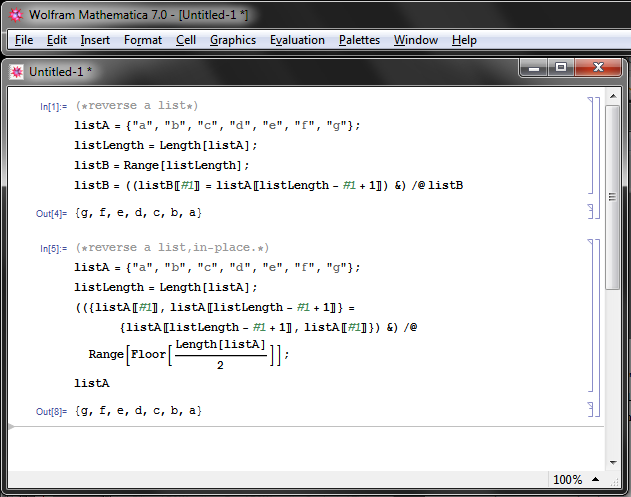Code Fun: Reverse List In-place (2012)
This page tells you what's “In-place algorithm”, using {python, perl, emacs lisp, Wolfram Language} code to illustrate.
In computer science, an in-place algorithm (or in Latin in situ) is an algorithm which transforms input using a data structure with a small, constant amount of extra storage space. The input is usually overwritten by the output as the algorithm executes. An algorithm which is not in-place is sometimes called not-in-place or out-of-place.
(from Wikipedia In-place algorithm)
Python 3
Here is a python code for reversing a list. Done by creating a new list, NOT using in-place:
# python3 # reverse a list, by creating new list_a = ["a", "b", "c", "d", "e", "f", "g"] list_length = len(list_a) list_b = [0] * list_length for i in range(list_length): list_b[i] = list_a[list_length -1 - i] print (list_b) # ['g', 'f', 'e', 'd', 'c', 'b', 'a']
Here is in-place algorithm for reversing a list:
# python3 # in-place algorithm for reversing a list list_a = ["a", "b", "c", "d", "e", "f", "g"] list_length = len(list_a) for i in range(list_length//2): list_a[i], list_a[ list_length -1 - i] = list_a[ list_length -1 - i], list_a[i] print(list_a) # ['g', 'f', 'e', 'd', 'c', 'b', 'a']
The a//b is for integer quotient.
Perl
Here is a perl version.
# perl # reverse a list, by creating new use strict; use Data::Dumper; my @listA = qw(a b c d e f g); my $listLength = scalar @listA; my @listB = (); for ( my $i = 0; $i < $listLength; $i++ ) { $listB[$i] = $listA[ $listLength - 1 - $i]; } print Dumper(\@listB);
# perl # in-place algorithm for reversing a list. use strict; use Data::Dumper; use POSIX; # for “floor” my @listA = qw(a b c d e f g); my $listLength = scalar @listA; for ( my $i = 0; $i < floor($listLength/2); $i++ ) { ($listA[$i], $listA[ $listLength - 1 - $i]) = ($listA[ $listLength - 1 - $i], $listA[$i]); } print Dumper(\@listA); __END__
emacs lisp
;; emacs lisp ;; reverse a array, by creating new (setq arrayA ["a" "b" "c" "d" "e" "f" "g"]) (setq arrayLength (length arrayA)) (setq arrayB (make-vector arrayLength 0)) (dotimes (i arrayLength ) (aset arrayB i (aref arrayA (- (1- arrayLength) i)))) (message "%s" arrayB) ;; [g f e d c b a]
;; emacs lisp ;; in-place algorithm for reversing a array (setq arrayA ["a" "b" "c" "d" "e" "f" "g"]) (setq arrayLength (length arrayA)) (dotimes (i (floor (/ arrayLength 2))) (let (x) (setq x (aref arrayA i)) (aset arrayA i (aref arrayA (- (1- arrayLength) i))) (aset arrayA (- (1- arrayLength) i) x) ) ) (message "%s" arrayA) ;; [g f e d c b a]
Wolfram Language
(*reverse a list, by creating new*) listA = {"a", "b", "c", "d", "e", "f", "g"}; listLength = Length@listA; listB = Range@listLength; listB = (listB[[#]] = listA[[listLength - # + 1]]) & /@ listB
(* reverse a list, in-place. *) listA = {"a", "b", "c", "d", "e", "f", "g"}; listLength = Length[listA]; ({listA[[#]], listA[[listLength - # + 1]]} = {listA[[listLength - # + 1]], listA[[#]]}) & /@ Range@Floor[Length@listA/2]; listA

Note: in-place algorithm are not encouraged in functional programing. So, in functional language such as {lisp, Wolfram Language}, the constructs above are a bit forced. The examples here are only for illustrating the concept of in-place algorithm. All the above langs have built-in functions for reversing a list.
2012-02-29 Thanks to Steven D'Aprano, Dan Stromberg.